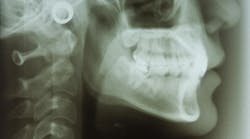Tonsils and the intraoral dental exam: What to look for
Tonsils, or palatine tonsils, are the pair of oval-shaped, lymphatic tissue mounds found at the base of the tongue.1 The human body uses the tonsils as a defense mechanism to help filter out germs and infections via their high concentration of white blood cells.1 In stages of generalized health, the tonsils appear pink in color. A patient can see them by opening their mouth and pressing their tongue downward. Palatine tonsils are evaluated by a medical specialist, specifically an ear, nose, and throat doctor (ENT). However, dental professionals can also monitor their patients’ tonsils at routine oral hygiene checkups.1-3
You may also be interested in … What goes on in a sleeping mouth?
Pathology of the tonsils
Despite having the job of keeping the body safe from germs, tonsils can become infected.1-3 These infections cause the tonsils to become red, painful, and enlarged.1-3 Diseases that can affect the tonsils include tonsillitis, strep throat, tonsillar stones, peritonsillar abscesses, mononucleosis, hypertrophic tonsils, and tonsillar cancer.1-3
- Tonsillitis describes inflammation of the tonsils.
- Strep throat is a bacterial infection from the Streptococcus bacteria that invades the tonsils.
- Tonsil stones are also known as tonsilloliths and occur when deposits of calcium accrue on the surface of the tonsils.
- Peritonsillar abscesses occur when a large pocket of pus develops on the wall of the tonsil and pushes it toward the center of the throat.
- Mononucleosis is a viral infection that can affect the tonsils, causing them to become enlarged and painful.
- Hypertrophic tonsils are extremely large tonsils that are part of the body’s natural anatomy. Typically, palatine tonsils are about 42.81 cubic centimeters, but some grow very large and can partially block the patient’s airway.1
- Tonsillar cancer is the most common type of oropharyngeal cancer and has been more recently linked to the human papillomavirus (HPV).1,2
These diseases may cause a patient to complain of pain or discomfort in the neck and throat areas. Each pathology requires a unique test to diagnose what is truly affecting the tonsils.1-3
You may also be interested in … The case of the silent lesion
Tonsils and the intraoral dental exam
Dental hygienists can examine a patient’s tonsillar area when performing an intraoral examination.3 To see the tonsils, ask the patient to open wide while depressing the dorsal surface of the tongue.
If the tonsils look enlarged, the hygienist may want to ask the patient if they naturally have tonsils that are larger than average. If the tonsils are erythematic, displaying calcium stones (such as little white dots) or exudate, a hygienist must inform the patient.1-4
Always record any pathology notes about the tonsils (including sizes, symptoms, and colors) in the patient’s record.3 If an intraoral camera is available in the operatory, take a picture of palatine tonsils.3
In addition to intraoral examination, palpate the patient’s lymph nodes (which can be felt on the neck) to see if they are swollen or feel tender.1 If the tonsillar region looks suspicious for pathology, more information can be gathered if the lymph nodes are also swollen.
Tonsillectomy and the pediatric patient
Recently, it has come to the attention of various health-care providers that pediatric patients need to have their palatine tonsils evaluated, and sometimes removed. In 2021, more than 530,000 tonsillectomies were performed on pediatric patients.3 Even though this high frequency makes it one of the most performed surgeries in this patient group, the number of tonsillectomy surgeries is declining.3
The two most common reasons an ENT may suggest a tonsillectomy in a pediatric patient are recurrent infections and sleep apnea.4 Typically, it is recommended that children who have a high frequency of strep throat, especially within a short period of time, have their palatine tonsils removed to reduce the chance of Streptococcus bacteria accumulating there.4 ENTs also recommend that pediatric patients with naturally hypertrophic tonsils have them removed, because they can cause sleep-disordered breathing (SDB) and possibly even sleep apnea. These conditions can also occur in patients with a healthy weight.4 Excessively large palatine tonsils can block the airway when a patient lies flat, thus depriving them of oxygen.4
There is a debate about whether removing the tonsils is the best option to treat SDB and recurrent cases of tonsillitis and strep throat.1,3,4 Due to this ongoing debate, pediatric tonsillectomy cases are slightly on the decline. Further research is needed to settle the discussion, and it may be that we see even fewer tonsillectomies performed in the future.
Tonsillar health and overall health
Dental hygienists can help patients and caregivers decide if a consultation with an ENT is needed to further assess the patient’s tonsils. Hygienists can review the patient’s medical history to see if there have been recurrent issues with infections of the tonsils, as well as ask about the patient’s quality of sleep. If the patient never feels rested despite sleeping for an adequate number of hours during the night, they may want to consider having an ENT evaluate their tonsil size for possible SBD.
Hygienists should perform intra- and extraoral cancer screenings on every patient at every appointment. Above all, discuss with young patients and their caregivers how keeping the oral cavity clean helps to promote good tonsillar health. In addition, gently remind patients and caregivers that anytime the tonsils become infected, the patient should immediately change their toothbrush and any other oral hygiene aids they’ve been using that could be carrying pathogenic bacteria.
Editor’s note: This article first appeared in Through the Loupes newsletter, a publication of the Endeavor Business Media Dental Group. Read more articles and subscribe to Through the Loupes.
References
- Tonsils. Cleveland Clinic. Reviewed July 7, 2022. Accessed July 12, 2023. https://my.clevelandclinic.org/health/body/23459-tonsils
- Laskin DM, Swecker TK. Oral cancer detection. Dimensions of Dental Hygiene. August 10, 2016. https://dimensionsofdentalhygiene.com/article/oral-cancer-detection/
- Drake AF, Meyers AD. Tonsillectomy. Medscape. Updated January 4, 2022. Accessed July 12, 2023. https://reference.medscape.com/article/872119-overview#a7
- Removing tonsils and adenoids: what is right for your child? The reasons for this common surgery. Cleveland Clinic. March 19, 2019. Accessed July 12, 2023. https://health.clevelandclinic.org/removing-tonsils-and-adenoids-right-for-your-child/
About the Author
Tracee S. Dahm, MS, BSDH, RDH
Tracee S. Dahm, MS, BSDH, RDH, is an adjunct clinical instructor for the North Idaho College School of Dental Hygiene in Coeur d’Alene, Idaho, and she also works in private practice. She has been published in several dental journals, magazines, webinars, and textbooks. Tracee is a key opinion leader on cutting-edge innovations in the hygiene field. Her research interests include trends in dental hygiene, improving access to dental care for the underserved, and mental health. Contact her at [email protected].


